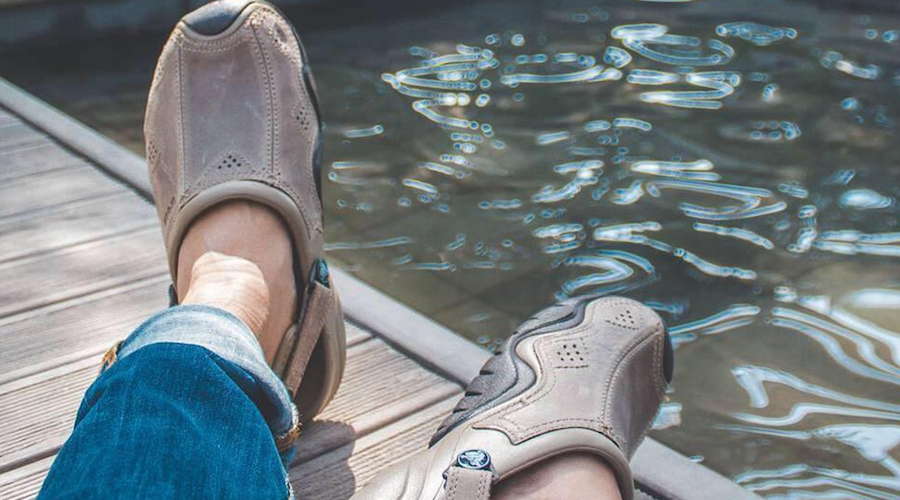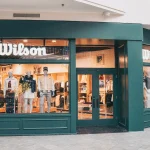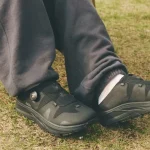Crocs again showed sharp improvement in earnings in the second quarter as a result of its ongoing efforts to cut expenses and avoid discount selling. More encouragingly, however, sales of its core merchandise are showing signs of picking up.
Second quarter revenues were $313.2 million, down 3.3 percent from a year ago but at the high end of guidance calling for sales in the range of $305 and $315 million. Foreign-currency translations decreased revenues by $2 million versus the same period a year ago.
The 3.3 percent drop primarily related to the sale of its Taiwan business, store closings and the additional actions taken to improve the quality of its revenues. Adjusted to exclude these items, Q2 revenues would have been up low-single digits compared to Q2 last year.
On a conference call with analysts, Andrew Rees, president and CEO, said sales of clogs, sandals, flips and slides – described as “Crocs DNA” – exceeded internal expectations
“Classic clogs turned in particularly strong results as we continue to leverage our iconic clog with fresh colors and prints,” said Rees. The Swiftwater Deck Clog line extension that addresses additional wearing occasions helped its Swiftwater collection surpass expectations. The CEO added, “New colors and prints are selling well, and it is especially gratifying to see wholesale accounts expanding the range of colors presented in their stores and on their retail sites.”
The women’s Capri and Sloane in the sandal category also exceeded expectations. Said Rees, “We’re striking the right balance of comfort and style and consumers are responding favorably.”
For holiday selling, Crocs will be focusing less on seasonal products such as boots while looking to capitalize on the momentum around its core categories, including introducing lime clogs.
Demand for Crocs is also being helped by the success of its Come As You Are campaign that’s particularly aimed at digital marketing effectiveness and consumer engagement. Brand social engagement, social reach, and PR coverage each roughly tripled compared to last year’s second quarter.
“Wholesale accounts have enthusiastically embraced the campaign, utilizing our creative in window takeovers and caps on selling fixtures and on their own websites,” said Rees. “In our DTC channel, our online and retail stores saw strong sell-through of the products featured in the campaign.”
Rees also noted that Crocs has entered into a product collaboration with Drew Barrymore, one of the stars of the campaign. He added, “Her designs will be introduced as part of our Spring/Summer 2018 collection with fresh, exciting new products, reflecting her personality and infectious enthusiasm. We believe her designs will be a great addition to our lineup.”
By channel, wholesale revenues declined 7.3 percent in the second quarter due to its intentional pullback from discount channels and reduced shipments to select overstocked distributors in Asia. Crocs began those initiatives during the third quarter of 2016 and expects them to have less of an impact on its year-over-year comparisons in the back half of this year.
Rees said wholesale accounts “did well with our Spring/Summer 2017 collection” and sell-throughs continue to improve.
“Furthermore, wholesale price selling improved, enabling our accounts to realize better product margin,” said Rees. “In conjunction with our activation of the Come As You Are campaign, we were given an expanded shelf space by some of our important key wholesale accounts, securing a longer placement period at some accounts and in other secured dedicated brand locations. All of those boosted the visibility of Crocs.”
DTC comp’s grew 5.7 percent. While overall retail sales declined 4.4 percent due to store closings, Crocs’ retail comp was flat. Crocs had 55 fewer stores compared to the end of last year’s second quarter, ending the quarter with 503.
Rees said retail performed in line with expectations. The CEO added, “We continue to make progress against our plans to rationalize our store fleet, closing or transferring 39 stores during the second quarter, moving more quickly than we had originally estimated.”
E-commerce grew 14.5 percent while generating a 17.8 percent comp, led by Asia.
Crocs sold 17.4 million pairs of shoes in the quarter, a 1.8 percent decrease from the prior year. The average selling price of footwear was $17.66, down 2.2 percent. The decline reflected its renewed focus on core molded product, which carries a lower ASP but generates a higher gross margin.
By region, revenues in the Americas came in at $136.2 million, up 0.8 percent. The performance marked a return to growth in every channel in the region.
Wholesale revenues grew 4.9 percent. Key accounts saw better than expected sell-throughs and wound up increasing at-once orders and bought into a more diverse product range than last year. Marketing collaborations with key family footwear accounts contributed to improved wholesale revenues as well.
America’s DTC comp increased 1.1 percent. The region’s retail comp grew 0.4 percent, while retail sales declined 3.8 percent, reflecting 11 fewer stores year over year. E-commerce sales advanced 2.6 percent. After a slow start, comps accelerated with double-digit comps in June as pricing and promotions were aligned to the competitive environment.
In Asia, revenues were $124.6 million, down 4.7 percent versus prior year. Wholesale revenues slumped 12.7 percent, largely due to the sale of its Taiwan business in the fourth quarter of 2016 and reduced sales to select overstock distributors. Growth was seen in Crocs’ China wholesale business, benefiting from repositioning efforts.
Asia’s second-quarter DTC comp increased 13.3 percent. The retail comp declined 0.9 percent. Retail sales dropped 4.6 percent, reflecting the comp performance and 30 fewer stores year over year. E-commerce sales jumped 34.8 percent, while e-commerce comp climbed 44.5 percent, reflecting the exclusion of Taiwan e-commerce results from last year. Most of e-commerce growth was driven by strong results in China and Japan.
In Europe, revenues were $52.3 million, down 9.3 percent versus the prior year. Wholesale revenues sunk 14.5 percent due to the planned reduction in discount channel sales. European’s DTC comp increased 5.1 percent. Retail comps inched up 0.7 percent, while retail sales declined 6.3 percent, reflecting 14 fewer stores as compared to last year’s second quarter. E-commerce sales grew 10.4 percent, driven by high conversion rates.
Net earnings rose 54.7 percent to $18.1 million, or 20 cents a share, exceeding Wall Street’s consensus estimate of 15 cents. Excluding $1.8 million related to SG&A reduction initiatives, non-GAAP net income attributable to common stockholders of $19.9 million, up 70.1 percent from adjusted earnings of $11.7 million, or 13 cents, in the prior year.
The bottom line was boosted by an improvement in gross margins by 180 basis points to 54.2 percent. The improvement reflected a continued focus on higher margin in molded product and fewer discount channel sales.
SG&A expenses were $140.4 million, down $8.7 million from the prior year. The $1.8 million in charges related to its SG&A reduction program was below the $3 million Crocs guided for at the end of Q1.
The meaningful SG&A improvement in part reflects the benefit of approximately $1 million related to a bad debt recovery, which had previously been reserved for in China. SG&A also was helped by a timing benefit of approximately $2 million related to marketing expense. The remaining improvement over prior year reflects the benefit of its SG&A reduction efforts, which includes store closures, store transfers and business model changes combined with operational improvements.
Rees said that as previously mentioned, 70 percent of the SG&A reduction is tied to reducing company operated stores. He added, “We have accelerated the pace of our store reductions and we’re now on track to have 19 net fewer stores by the end of this year.”
Looking ahead, Crocs expects third quarter 2017 revenues to be between $230 and $240 million, compared to $245.9 million in last year’s third quarter. Gross margin is expected to be essentially flat. Year-ago margins benefited by more than 200 basis points due to a favorable inventory adjustment. SG&A is projected to be down approximately $3 million to last year, including approximately $2 million of charges associated with SG&A reduction initiative.
For the full year, Crocs continues to expect revenues to be down low-single digits compared to 2016, reflecting its ongoing repositioning efforts and an accelerated pace of store closings. Gross margins are expected to continue to be approximately 50 percent.
SG&A for 2017 is expected to be between $490 and $495 million, an improvement over its previous guidance of $495 million and $500 million, and $10 million to $15 million below the 2016 SG&A of $506.3 million. This lower range reflects the improvement realized in the second quarter, as well as the accelerated pace of store closings.
Rees concluded, “In closing, we are right on track. The actions we have taken and additional actions we’ve taken through the balance of the year are transforming Crocs into a more nimble and stronger company, capable of in the face of a challenging retail environment.”
Photo courtesy Crocs
















